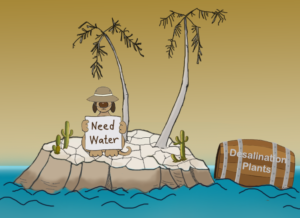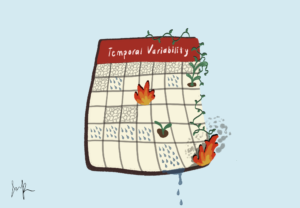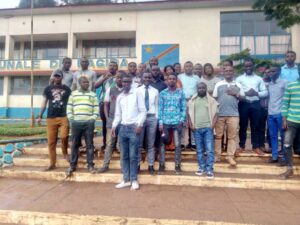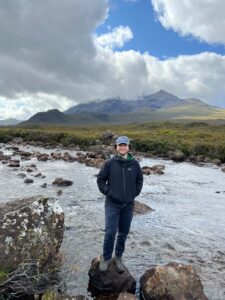
We recently had the wonderful opportunity to interview Professor Brent Haddad, Professor of Environmental Studies at the University of California, Santa Cruz, about California’s drought and water situation. At the beginning of the year, California experienced an atmospheric river storm, a phenomenon in which “there is air with a large amount of water in it, flowing in a particular direction” (Haddad). Professor Haddad added that this is “certainly not like a river in the sky, but rather moist air that flew in our direction and came across from the Central Pacific and came down upon us.” (Haddad). We discussed the implications of these storms, wildfires, climate change, agriculture, and solutions.
Hello, Professor Haddad! Thank you for joining us for an Earth Chronicles Interview. We appreciate this opportunity to hear from an expert on some questions we have long held about the California water crisis.
1. Could you tell us a bit about yourself?
My name is Brent Haddad. I am a professor at the University of California Santa Cruz. I grew up in Los Angeles, and I went to college mainly in the Bay Area of California. I research, teach, and publish about sustainable water systems.
2. Thank you very much. So we first want to talk about the droughts and storms that California has been experiencing. Before the atmospheric storm in the recent month, there were lots of headlines and articles talking about the California drought and how the Colorado River was at 34% of its peak capacity. Did these rain storms help at all with the drought? In other words, did the rain go where it needed to be?
A very large storm that lasts for a few days in the middle of an extended drought will certainly help. However, it will not solve a drought. It really depends on whether or not we get more rain storms because a good year for California is 5-7 big storms in the rainy season. Then, we are in really good shape. And we can certainly expect more big storms in the future; big storms have been a part of California’s past, and climate change scenarios show that, if anything, we will get even bigger storms in the future.
3. So, do you think that the drought we’ve been experiencing can recover naturally from continuous storms like these?
Yes, if we have enough of them, we can recover from the drought. But it would take a few years to really get back to having the drought in the rearview mirror, because we need to refill groundwater systems. And groundwater takes longer to recover.
4. It’s amazing what a couple of weeks of rain can do. Already, there’s a lot of green around us, which is very unusual for a Californian to see. This heavy rain and rich soil can help trees and plants grow. So, our next question is: Is this potential fuel for wildfires, or is this helping to prevent wildfires in the future?
It’s definitely fuel. It’s important to remember that wildfires are a natural part of the California landscape. It’s just that for the past hundred and fifty years, we have been suppressing fires where we’ve had people and farms and cities and rangelands. That just means by putting fires out quickly when they come; we keep building up the fuel. So, we’ve had some major fires, and we’re likely to have more major fires in the future because we have such a huge fuel source built up in the lands of California.
5. So, would the best option right now be to allow fires to keep burning and avoid suppressing them?
I would say that we have to be ready to protect towns and essential infrastructure like electricity grids and water pipes. It’s not an easy problem to solve because you never know where lightning is going to strike. We just have to be ready and flexible. California has a statewide firefighting group called Cal Fire. They have to be ready to coordinate with the local fire departments and go out and fight these fires, protect cities and homes, and also help with the recovery afterward.
6. A lot of people are correlating climate change to extreme weather like droughts, the storms we just experienced, and wildfires. In your opinion, does global warming have any effect on extreme weather? In particular, the storm we experienced recently.
I’m glad you put “in your opinion” in your question, because no one can say for sure. But I can say this. The models of how the climate is likely to behave in light of the addition of greenhouse gasses to the atmosphere all predict the kinds of things we are seeing: more extremes in our water systems, more extreme droughts, and more extreme storms. So, I would say that it is consistent with climate change scenarios. So, I would say, in my opinion, climate change is partially responsible for how extreme storms and droughts are.
7. Now, we move on to the Agriculture question. California grows lots of water-intensive crops like almonds and alfalfa. We also produce ⅕ of the nation’s dairy. And since a vast majority of our water goes towards agribusiness, do the crops we grow and food choices we make hold significance in how we can conserve water?
There is no question that if we grew less alfalfa and fewer pasture-type crops, we would have more water available in our system. But, then the question turns to: what do we do with the system based on private ownership of farms where farmers decide what they grow, not the government? And that seems to be where we have gotten stopped. We haven’t had famines in North America, and we have food surpluses to export around the world. From that perspective, our system of giving farmers the freedom to make decisions based on market signals is working pretty well. However, it’s not working well when you think about water shortages and, in some cases, too much fertilizer and agricultural chemicals being applied to farms. Not to mention the inequalities between farm workers and farm owners. Other issues with farming are also serious. I guess the point is this: the question of whether we should regulate how people grow or even what technology they use to irrigate their crops—that’s part of a larger discussion of the government’s role in the agricultural sector. And it’s an important discussion to have because they do have a huge role already. And now, the question is whether it’s the right role, how it can be improved, and how we can get better outcomes for all of society without messing things up.
8. Do we need to collectively change any specific food intake?
The discussion on food intake is something that is extremely complicated. We shouldn’t just say, “stop eating beef,” because there may be cultural reasons to eat beef, or it may depend on what is available to provide sufficient calories for a family. But, absolutely. We are talking now about individual choice, and individuals can certainly make choices about what they eat, not just in terms of their own health but in terms of the potential damage and costs of producing that food. For example, if it’s produced in a way that seems to be unjust because it’s enriching some people while making others poorer. Or if it’s damaging the environment severely.
I think it’s really important that you mentioned that there are factors that could prevent one from reducing their intake of certain foods or choosing not to eat something. Nowadays, this has been a very controversial topic, and I think it’s worth discussing. We know that producing meat consumes lots of water. And if we had used the same amount of land, the same amount of water, and the same amount of resources to grow crops and feed vegetables to people rather than meat, we could feed even more people and optimize our resource use. But then, we also have to consider the cultural aspects because some cultures depend on meat. This has been a question of ours for a long time, so thank you for your great answer.
9. Finally, we wanted to discuss the solutions to these problems. The US Bureau of Reclamation (USBR) gave the 7 Colorado River states until mid-August last year to figure out how to reduce their water usage (the goal was to cut annual water usage by 15-30% starting 2023). Although they’re still developing a plan, is this an effective way for states to start reducing their water consumption? And if so, is policy control a huge tool that we need to start using to enact massive change, not just water issues?
I believe they have a deadline in the next few days, and it appears they are not going to create their own deadlines. All these states are negotiating together, and it’s proving very difficult with each state saying, “You can do more. We’re doing all we can.” But asking for voluntary reductions is absolutely the first place to begin. However, if the government is going to see action with voluntary reductions, there has to be a very clear consequence that the government will act if the reductions aren’t realized. Oftentimes, the way states look at it is that it is bad enough if we have to figure out for ourselves how to cut back. But it’s worse if the government tells us how to cut back, because at least we have the most information about how we use our water at our disposal. The government has some of that information but not all of it. So they may not come up with the best solutions or ways to reduce water usage. If the government creates that context, you will likely see voluntary action. So it’s a very good starting point. In fact, states have already taken action on the Colorado River. There have been different triggers.
Tier 1 drought was triggered in 2021 in the Southern states (Arizona, Nevada, and California); these Tier 1 cutbacks only impacted Nevada and Arizona and cut back their allocations by a few percent. But at the beginning of this year, they went to Tier 2A, which is a slightly greater cutback. Nowhere near the 15 to 30%, and more like 5%. For example, Nevada’s overall allocations dropped from 300,000 to 275,000 acre/feet per year. So, now this question of 15-30% is a much bigger challenge for the states. If they cannot come up with a plan (which is highly difficult, so I am not surprised if they don’t), the Bureau of Reclamation will impose a plan and probably should impose a plan. So, policy control is a huge tool.
10. Is there any particular policy that you recommend should be enacted?
So, we’re talking about the colorado river region. There are types of water uses that people have enjoyed for a long time, like watering lawns. And, especially in the southern Colorado region, the grass that makes up lawns are non-native grasses from the eastern parts of the continent, Asia, or Europe, where there is rain year-round. The grass is a species that wouldn’t survive on its own if they were just left here. Nevertheless, we’re watering them all the time to keep them green. We should give enormous incentives for people to replace all the grass in front yards, backyards, and along median strips with drought-friendly landscapes. People will figure out how to make it look nice. We are all really comfortable with green grassy lawns now, but if we try new things, we will find things we like. There are exceptions, like grass in graveyards or children’s parks, but by and large, outdoor irrigation of grass is a significant place to start. Some regions that are leaders in this are the southern Nevada regions. They have done a great job of transitioning away from grass. And as we talked about earlier, we will need to provide some incentives to move away from at least summer alfalfa growing when it’s least efficient. In the summer, you need to apply lots of water for alfalfa, and you don’t get lots of crops for it compared to fall, winter, and spring. We should definitely create incentives and rules to end the practice of summer irrigation of alfalfa.
11. What is your opinion on gray water systems?
A lot of the time, when people think about gray water systems, they think about household use. But we need to expand this idea and think about what to do with all the wastewater produced in cities and farming areas with run-ons. California is one of the national leaders in recycling water and reusing it. But there is more that can be done everywhere. So, a gray water system will help keep a garden going for some homes, especially in a very serious drought. Outdoor use is one of the main ways you can use a gray water system. So, it’s really more of a major investment of millions or even billions of dollars to really improve our water reuse systems.
12. Other than policies, what is something we need to do as citizens?
Well, you’re doing it right now. You’re learning about it right now and becoming more and more educated about water systems. Also, by following what your water department is doing, whether it’s part of the city, a separate water agency, or even a private water company, citizens can influence their decisions by showing up at their public meetings or writing letters, either directly to the agency or to editors. If you feel that there aren’t enough incentives for water conservation, if the service isn’t good enough, or if you think they’re doing a fabulous job, speaking up is a way citizens can influence what is going on.
Another thing you can do is run for a position on the water board. There are water boards everywhere, and it’s an elected office where anyone, even high school students, can run to serve on the water board. And then, you have oversight over the water system because the water board is the board of directors. That is if you have a water agency. If it’s part of the city, there will be water advisory committees set up for citizens. In other words, there are formal ways for citizens to get involved. Not just pestering with letters and statements, but even serving on the board and getting yourself elected is a way to contribute directly.
13. Do you have any advice on how students and schools specifically can contribute?
Here is something you could do at your school. This might take a little bit of money. Purchase a water quality testing kit, which I bet your chemistry teacher can help with. You can raise a little money for a water quality testing kit, which will not be too expensive. Then, go to a drinking fountain or tap in the school kitchen to test the water. Make it a project. You can report the quality of school water in your school newspaper. There’s something called the Consumer Confidence Report that comes out every year or every two years; every city or water agency has to produce one. You can just download it for San Ramon and then compare your water quality to the report. The nice thing about the report is that it will list all of the types of potential water pollutants, both the federal standard of low-quality water without having a violation and what the water agency reports from their testing. So you can compare your testing to what is the official standard and what the water agency says is happening in the system. And then, you publish that on your website.
14. And, last question. I’m a coder, and I’m really interested in finding ways to help the environment through computer science and technology. Besides simply reducing water consumption, are there any specific technological advancements that could help us combat drought conditions?
Coding is going to be part of any larger solution because the information is critical to water management. And this is the kind of information that matters: how is water quality changing in particular places, how are groundwater levels rising or falling over time, and how much water is being used for different purposes in the city or on the farm, for that matter. As a coder, there will be lots of opportunities for you to be involved in water protection and conservation. And I’ll mention one other thing. I just had a wonderful conversation with a professor here at UC Santa Cruz whom I hadn’t met before. She’s involved in something called Serious Games. And Serious Games are simulations that people get involved in to point out a problem in society that people otherwise wouldn’t think about. For example, it might be a game about ten farmers, and everyone plays a farmer with a groundwater well. So, one season after another happens. And at first, farmers are taking all the groundwater they think they want, and the groundwater basin keeps going down because it’s all programmed into the game to decrease until their wells start drying. So, farmers, or the players, have to start self-regulating or choose to take or not take water. You can try out different regulations or individual actions. Everyone has this incentive to take a lot of water to make more money, but if everyone takes all that water, the groundwater dries up. These games and simulations that teach people about problems in society are what a coder can work on. Let me just also add that your knowledge of mathematics and statistics will matter. Coding, combined with a strong science background, will take you a long way to solving these problems. There is the social side related to equality and fairness, which you can’t discount. But if you want to be in on the engineering and the development of solutions, I would say the STEM classes are great.
Thank you so much, Professor Haddad. It was a pleasure to interview you!
If you would like to learn more about Professor Haddad’s great work and research, visit his page here.









